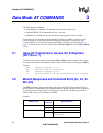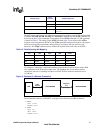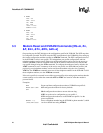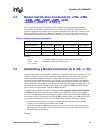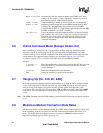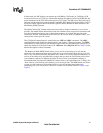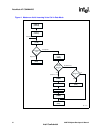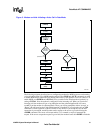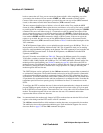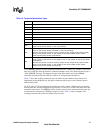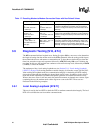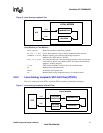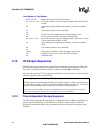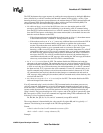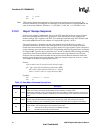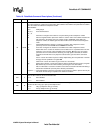
34 536EX Chipset Developer’s Manual
Intel Confidential
Data Mode AT COMMANDS
hook to connect the call. Now you can answer the phone and talk. After completing your voice
conversation, the modem will issue another +PMHF and ATO command to initiate a Quick
Connect. If the server rejects the request to go on hold, the user can stay on line (ATO command
issued) or disconnect from his initial data connection (ATH command issued).
The next sequence describes how to initiate a voice call while online. First, enable the MOH
feature by setting +PMH=0. When online, the user can initiate a voice call by first issuing +++AT
to put the modem in command mode. Then request the server to go on hold by issuing the +PMHR
command. The server will either accept (1–13 returned) or reject (0 returned) the request. If the
server accepts the request to go on hold, the modem issues the +PMHF to flash the hook and get
dial tone. You can then make a voice call. After completing the voice conversation, the modem will
issue another +PMHF and ATO command to initiate a Quick Connect. If the server rejects the
request to go on hold, the user can stay on line (ATO command issued) or disconnect from his
initial data connection (ATH command issued). Refer to Table 5 for the detailed description of the
V.92 commands.
The PCM Upstream feature allows you to upload data to the network up to 48,000 bps. This is an
improvement over the 33,600 bps maximum with V.90. This is beneficial when you are sending
large file, email attachments and gaming on the Internet. The +PIG command is used to enable and
disable the PCM Upstream feature. To enable PCM Upstream, set +PIG=0. To disable PCM
Upstream, set +PIG=1.
Several V.34 modes are available (see Table 16). These provide different speeds. For example,
V34S offers a modem-to-modem data rate of 2400, 4800, 7200, 9600, 12,000, 14,400, 16,800,
19,200, 21,600, 24,000, 26,400, and 28,800 bps. For V.42, MNP, and Buffer (Normal) modes, the
modem provides speed buffering (see Section 4 starting on page 56), which allows the DTE-to-
modem data rate to be different from the modem-to-modem data rate. Users can take advantage of
this feature by setting the DTE-to-modem rate to a high speed like 115,200 bps and letting the
modem negotiate the best line rate.
The 536EX chipsets can be configured (by the +MS=m command) to support either asymmetrical
or symmetrical connections. The modem transmits and receives at the same speed in symmetrical
connections and at different speeds in asymmetrical mode. V.90 and V.92 connections are always
asymmetrical. V.34 mode connections can be either symmetrical or asymmetrical. The modem uses
six parameters for asymmetrical modes and four parameters for symmetrical modes. Note that the
transmitter speed and receiver speeds typically are different for most V.34 connections over the
PSTN.
To configure the DTE-to-modem data rate (in data on-hook command mode), change the terminal
program COM port speed selection or write the appropriate divisor latch values for a given speed
to the UART Divisor Latch registers. Then send an
AT<CR> or any other valid AT command to the
modem. The modem responds with an
OK at the new data rate. All commands and modem
responses that follow use the new data rate.
Note: In command mode, the modem only changes its DTE-to-modem data rate after the Divisor Latch
register values change and the DTE sends a valid AT command.
The +MS=m command defines which modem-to-modem data rates are supported by the modem.
The table below shows the supported modulation types. Each modulation supports one or more
data rates. Refer to page 53 for the +MS command description.



